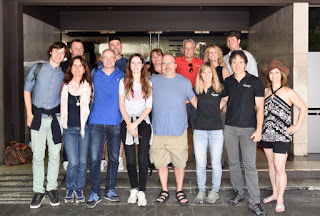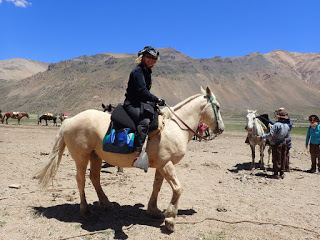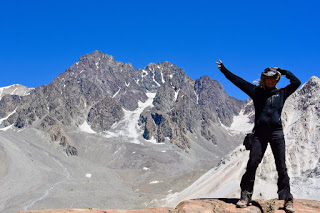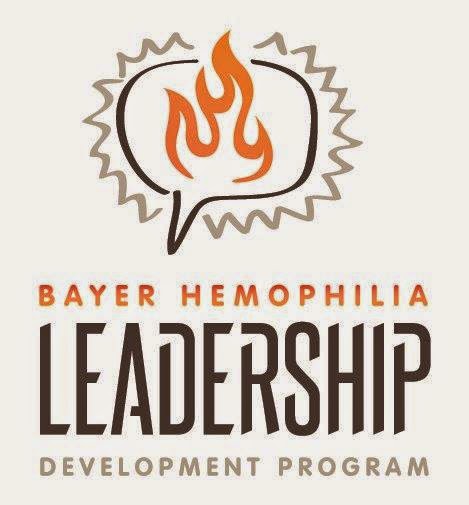Andes Survivor Expedition: Resilience, Dignity, Strength
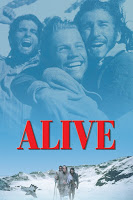 Resilience is not the ability to recover. It is the ability to go through hell, to endure
Resilience is not the ability to recover. It is the ability to go through hell, to endurethe indescribable, and not to break. —Pedro Algorta, survivor
a story that tore at hearts, shocked others, made new believers of God, and made some turn away from faith forever. It’s a story you couldn’t make up, that plumbed the depths of the human heart and soul. How does one survive the impossible, and still retain dignity, humor, compassion, teamwork?
of the Andes, by survivor Nando Parredo (two times) and I Had to Survive by Roberto Canessa (two times). I’m currently reading Pedro Algorta’s book Into the Mountains. Nando and Roberto were the two survivors who literally climbed out of the Andes, after 60 days on the mountain, to seek help. (To this day, it seems utterly superhuman and impossible.) I have watched the movie Alive countless times.
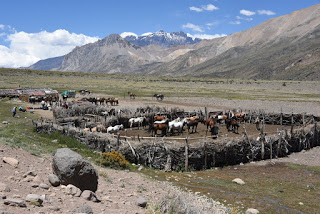 To meet Eduardo was to meet someone legendary. Nowhere in history is there a story quite like that of the Andes survivors. Eduardo is at once dignified and friendly; a man with
To meet Eduardo was to meet someone legendary. Nowhere in history is there a story quite like that of the Andes survivors. Eduardo is at once dignified and friendly; a man withan incredible history, and story to tell, who lives in the moment; famous, but makes you feel as though you are the important one. We instantly liked him, and our frozen awe began to thaw to a warm friendship feeling. He is truly a wonderful person to know.
on a horse. With me was Angela Forsyth, a physical therapist from New Jersey, who works for Diplomat and who I’ve known for probably 20 years. Our first day then was this
four-hour car ride followed by a four-hour horseback ride across an incredibly windy
flatland that threatened to permanently remove my cowboy hat, then up winding dirt paths into the mountains. We crossed several rushing rivers that swept the accompanying, yelping dogs downstream and soaked our hiking boots. We made camp that evening in a beautiful little valley, where the majestic Andes towered all about us. We also had a small team with us to cook, handle the horses, and help out with packing.
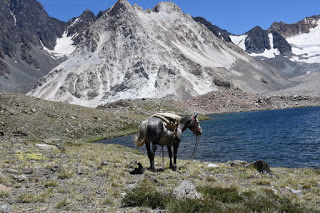 The next day, Wednesday, we took a seven-hour roundtrip horseback ride up treacherously tricky slopes, covered with nothing but rocks—the poor horses!—often at 45° angles. It seemed we should have rode mountain goats instead of horses, but the
The next day, Wednesday, we took a seven-hour roundtrip horseback ride up treacherously tricky slopes, covered with nothing but rocks—the poor horses!—often at 45° angles. It seemed we should have rode mountain goats instead of horses, but thesteeds handled it well, though they often looked quite wary. Our reward was a beautiful
mountain lagoon, left over from a glacial runoff.
issues from the tremendous dust kicked up by the horses as we rode, or a virus that
hitched a ride from Spain with Clara, one of the guests. Was I disappointed not to get to the crash site, which was the whole point of the expedition? Not really. First, Clara, the lady from Spain, is the niece of one of the young men who died on impact from the crash. It was more important that she go to the site with Eduardo. She had been sick the day before, but she rallied, and they went.
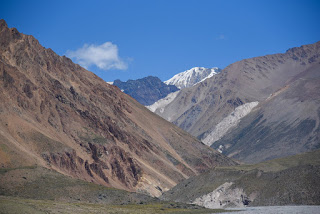 Second, I felt privileged to meet Eduardo, a survivor of this terrible yet timeless event, and that was enough for me. He sat with us in the evening after dinner in the mess tent, and answered our many questions about his experience. Our questions were candid but sensitive. We asked him about leadership: how and when did he and his two cousins become the de facto leaders of the group? About the role of women: how did the boys treat one another after Liliana, the “mother” of the group, died in the avalanche? (Without her feminine presence, the boys became a bit more aggressive with one another) About faith: did this experience deepen his faith in God? (The Read book made much of the issue of faith. Answer: no) About survivor’s guilt: did he suffer from it? (No) The worst part of the experience? (The avalanche)
Second, I felt privileged to meet Eduardo, a survivor of this terrible yet timeless event, and that was enough for me. He sat with us in the evening after dinner in the mess tent, and answered our many questions about his experience. Our questions were candid but sensitive. We asked him about leadership: how and when did he and his two cousins become the de facto leaders of the group? About the role of women: how did the boys treat one another after Liliana, the “mother” of the group, died in the avalanche? (Without her feminine presence, the boys became a bit more aggressive with one another) About faith: did this experience deepen his faith in God? (The Read book made much of the issue of faith. Answer: no) About survivor’s guilt: did he suffer from it? (No) The worst part of the experience? (The avalanche)pedestal. He is relatable, real, though his experience was surreal. We ate dinners together as a group, shared stories, teased one another, laughed, chatted about normal things. We shared a laugh when Ricardo wanted to put Angie and me in one very small tent. We are not ones to complain but… Ricardo looked over at Eduardo’s larger tent and said, “Well, maybe I could ask Eduardo…” But I said,
no, whatever Eduardo wants, Eduardo gets. But after looking again at the small tent… I said to go ahead and please ask Eduardo. I apologized later for kicking my hero out of his tent! He laughed and graciously accepted the swap.
conditions, read the books I mentioned. At the very least, watch the movie Alive. When you ask people about the greatest survival story ever, most people will mention Shackleton and the failed Antarctic expedition. But he has nothing on this story. To me, the Andes plane crash story is the greatest story of survival, and I have read so many. It’s a story of deepest humanity, of people at
their best.
could tell my readers one or two things he took away from his experience, what he would tell us?** “First, the power of love,” he replied. When you lose everything, and can rely only on one another,
you learn the true meaning of love. “Love is everything. We loved one another and cared for one another up there. And our love for our families back home kept us going.” The second thing?
others to wait, never knowing whether a rescue would come, whether the two had fallen into a crevasse, or were killed in an avalanche or simply starved to death. Their epic climb out got all the headlines, but it took incredible strength to simply wait in the fuselage and not give up hope.
any misquotation.

